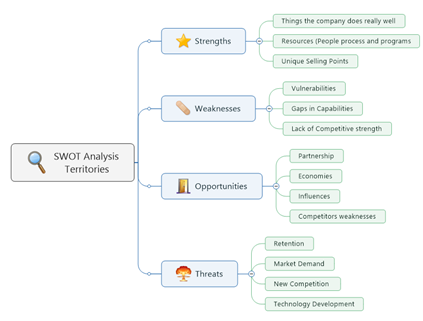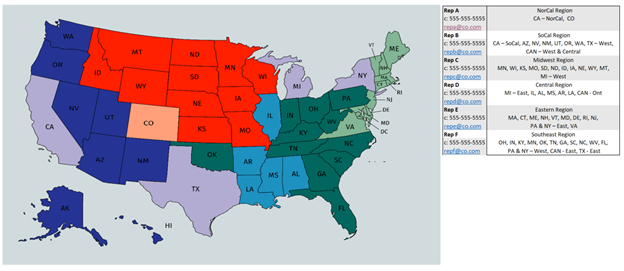Sales teams today are challenged more than ever. We are seeing rapid changes with the advent of new and quickly evolving markets. From the need to stay connected in the current work/home environments, to the demands and needs of buyers that are shifting rapidly as legislation (think GDPR, COPPA, etc), economic pressure, and other factors influence how we sell. We must adopt new methodologies today to adapt in this ever-changing world. A vital part of this change is how to reach and sell to our customers and prospects. If you lack a strong and flexible sales territory plan, your sales team may feel lost and not able to obtain their goals, and if you look at this honestly you will not produce the expected results for your organization.

What Is Sales Territory Planning?
Traditional sales territory planning is complex and can become a complicated process. Now that most sales teams are working remotely, these complications have increased greatly. For example, the selling strategies that we relied upon at the beginning of 2020 are not going to work now. Gone are those in-person meetings. In today’s business climate, you need to understand the changes and learn how to become flexible. You must constantly analyze and optimize your team’s territories in order to have a clear understanding of where your current sales opportunities are.
Territory planning is not a once a year exercise – it is a constant and flexible plan to ensure your sales team is targeting the right customers and prospects to maximize opportunities to increase revenue. When it comes to balancing and realigning territories, the traditional approach is a review of a vast amount of data from your CRM/ERP system, as well as using tools such as ZoomInfo, LinkedIn Sales Navigator, and Prospect.io. These help to gather your initial TAM (the “Total Addressable Market”).
An active and successful sales territory plan lays the groundwork and guidance to measure sales potential, set obtainable goals, and focus your team’s sales efforts for maximum success. This plan provides the organization the ability to properly identify and understand your customers and prospects, assess and measure value, and support existing customers, which will increase loyalty and decrease churn.
Territory management should always include an action plan that should include various stakeholders in the company, specifically the leaders of each of your Sales, Marketing, and Customer Success teams. This action plan should be built to be flexible. In a world where market opportunities change every day, the sales territory plan should be designed to be nimble, thereby ensuring that your action plan keeps up with changing opportunities and threats. Gone are the days of an annual territory planning session. It’s important that change management is built into the territory management program to ensure your organization is not surprised with every changing market forces.
Analyze Your Business Goals and Objectives
The first step to drafting a solid sales territory plan is having a clear and concise understanding of Your Product (What pain do your offerings solve for customers, what is organization’s most current vision, what is your mission, etc), Your Market (What are the key trends in the industry or market you serve), Your Competition. (Who are they, how do you differentiate yourself?) You then apply your defined organizational goals, and continually assess industry trends. This is a basic step to set the foundation on what you and your team will need to accomplish with your sales territory plan.
As you go through the above process, you should continually review and analyze this data to maintain a pulse on whether your plan is directing the efforts of what your sales team has set out to do.
- What are your sales goals, in numbers?
- What is your conversion rate?
- Based on this how many prospects should you have in your funnel at any given time to ensure that you’re meeting your sales goals?
To start, you need to be able to answer these questions.
What is the total addressable market (TAM)?
- What are the sales addressable market or who can I reach with my sales team (SAM)?
- Who is my target market (who are the buyers)?
- Who are my customers today (existing market)?

Step 1. Define your market, analyze, and segment existing customers.
Your first look will be to your customers, review and document Company specifics, the NAICS, or SIC codes of these Customers (Use the 6 digits to identify Sector, Subsector Industry group and Industry for the potential to create mini-TAMs), Now you should split up your customers into segments based on various characteristics such as: Industry, geolocation, revenue band, employee size, your customers purchase history (#of Users, Annual Contract Value), or whatever else is relevant to your organization.
Now you should consider, “Where do my customers fit?” Categorize your customers into three groups.
- The first group should be your SMB (small and medium business) customers.
- The second group of customers: Your MM (mid-market) customers.
- The third group should be Your EE (Large Enterprise) customers.
With these groups formed, you can identify the average contract value for each group, which will help identify the potential in each territory. As an example; in your initial analyses, you identify that there is 5,000 SMB prospects and your average SMB customers ACV (Annual Contract Value) is $2,000, additionally you identify 3,000 MM prospects with and average customer ACV of $5,000 and 500 EE prospects with an ACV of $12,000. You would then have a TAM of $31,000,000 with 8,500 prospects.
Now you need to discover what key trends are in your geography or market, look over the sales data that’s already been collected in your CRM. Analyze the data from previous quarters and years to better understand buying patterns, for this you will need to do research to learn why they are purchasing your product (or not), what they purchased, what drove the sale to go through, and what are the conversion rates from ToFu, MoFu and BoFu (top, middle and bottom of the sales funnel).
Step 2. Conduct a SWOT analysis.
SWOT is a vital next step that you should conduct for every territory plan. Working with your Sales Management team, identify your sales team’s internal strengths and weaknesses and external opportunities and threats with what is known as a SWOT analysis.
A SWOT analysis is a process that identifies internal and external factors that can affect the organization’s performance. When you have a better understanding of your strengths, weaknesses, opportunities and threats, you can develop a stronger sales territory plan.

For this analysis you are evaluating your present state for Strength and Weakness, this can include factors relating to products, pricing, costs, profitability, performance, quality, people, skills, adaptability, brands, services, reputation, processes, infrastructure, etc. For Opportunities and Threats, these factors tend to be in the future. For example: factors relating to markets, audience, competition, economics, politics, society, culture, technology, environmental, media, law, etc.
Strengths examples:
- Advantages of your tool?
- Capabilities of your tool?
- Competitive advantages?
- USP’s (unique selling points)?
- Resources, Assets, People?
- Experience, knowledge, data?
- Marketing – reach, distribution, awareness?
- Innovative aspects?
- Price, value, quality?
Weaknesses Examples:
Which weaknesses do you need to respond to? Think about weaknesses amongst your team, but also in the sales process.
- Disadvantages of your tool?
- Gaps in capabilities?
- Lack of competitive strength?
- Reputation, presence and reach?
- Financials?
- Timescales, deadlines and pressures?
- effects on core activities, distraction?
- Reliability of data, plan predictability?
- Processes and systems, etc.?
Opportunities Examples:
Are there any opportunities in your marketplace you can take advantage of?
- Market developments?
- Competitors’ vulnerabilities?
- Industry or lifestyle trends?
- Technology development and innovation?
- Global influences?
- New markets, vertical, horizontal?
- Niche target markets?
- Geographical, export, import?
- Market response to tactics, e.g., surprise?
- Business and product development?
- Partnerships, distribution?
Threats Examples:
Look at the biggest threats in each territory and consider what threats in your selling environment you’ll defend against. Some threats you may discover include:
- IT developments?
- Competitor intentions – various?
- Market demand?
- New technologies, services, ideas?
- Vital contracts and partners?
- Obstacles faced?
- Insurmountable weaknesses?
- Employment market?
- Financial and credit pressures?
- Economy – home, abroad?
Step 3. Set goals and create targets (SAM).
To make a successful sales territory plan, you must create clear parameters and realistic goals for the team as well as individual sales reps’ territories.
To do this, consolidate the trends you’ve discovered from the SWOT analysis above to come up with S.M.A.R.T (Specific, Measurable, Achievable, Relevant, and Time-based) goals and realistic targets.
Below is a list of question you should consider:
- How will you generate new leads?
- Where do most of your leads come from?
- Which geographical regions should you concentrate on?
- How many new opportunities do you need to meet quota?
- How will you go through current accounts?
- What resources do your sales reps need to manage their accounts?
- How can you leverage current successes?
- Have sales increased or decreased in a specific region or market?
- Are there any disparities between sales in different territories?
- Are any sales reps struggling to keep up with their leads?
- Are any markets under-served and in need of more assigned sales reps?
- Which products or services are most profitable? Who is purchasing them?
Having sales quotas is the most effective way to motivate sales reps, but if you find the team is not meeting those quotas, there is a problem. Is there a weakness in the sales pipeline, or a “spray and pray” marketing methodology not delivering that quantity and quality leads and opportunities needed.
To set attainable goals for the team, you should use the top-down approach.
This approach to sales quotas (you set a goal for the period and then assign quotas to support this goal), you then should review and analyze sales data from the prior periods to understand what the team was able to achieve in the past (How many leads are needed, what is the conversion rate to pipeline, how long from pipeline to closed sales). This will help develop the realistic goal for the future.
Step 4. Develop strategies to accomplish your goals.
Now understanding your customer segments and with goals in place, it’s time to create an action plan to succeed.
Applying the information collected so far, you should begin to develop a distribution of specific regions or markets among each individual rep.

The SWOT analysis mentioned above gives you a better idea of how to best assign your team member, additionally looking at Rep tenure, skills and talents to a specific territory. The customer segmentation analysis will help guide you on the number and quality of prospects in the territory and help figure out how often different accounts should be contacted and how to contact them. When creating your action plan, don’t forget to look at what the high-leverage actions are, what resources are needed, who is responsible, what are the key milestones.
5. Review and track your results.
The final part of a SMART sales territory plan is to always review and track the results to continuously optimize territory division. This is vital for measuring progress to understand how the plan is impacting sales.
Your plan design is your guide to produce intended results and fine-tune it on a regular basis when needed.
Within each part of your plan, you should always know the answer to the following questions:
- What is the territory’s closed business YTD?
- What is the territory’s quota?
- What is the territory’s gap?
- How much pipeline do I have today?
- What is the territory’s pipeline gap?
- What are my goals for the year?
Additionally, as part of this ongoing review and analysis, you will need to constantly evaluate the top accounts and where they fit in your territory plan. Who are the top accounts, what is our engagement, why have they been chosen (relationships, industry fit, target profile)? For each account, detail in one sentence, a clear and focused outreach strategy for these accounts.
Next, create an opportunity map and make sure opportunity plans are thorough. What’s the compelling event? Why now? What’s the strategy to engage with a champion and economic buyer? What’s the mutual success plan?

Finally, close out with strategies to build your sales funnel.
In addition to being responsive to external factors, action plans should be reviewed on a quarterly basis to ensure your plan isn’t going stale unintentionally. With each plan review, it’s important to review with your leadership if this data requires a modification to your territory plans. When you proactively monitor this plan against the results, you will maintain a plan that keeps you relevant with your customers and industry.
Other considerations:
Historically, most territories were segmented by geography, but in this new on-line and connected world, additional segmentation should also be considered, such as:
- Industry
- Revenue
- Employee size
- Customer type
With your plan make sure you have clearly defined territories, including any overlays, segmentations and so on, this will set up your sales teams to work strategically to address the needs of their assigned market. The plan should show your sales team, how they can meet and exceed their goals (quota). This will ensure that the sales team’s efforts stay focused on the who, what, when, where and why in their territory. Have a method to continually measure your team related to the sales pipeline.
Track your KPI’s (The number of attempts it takes to establish contacts, get leads and make sales):
- Marketing qualified leads (MQLs) to Sales qualified leads (SQL) to new opportunity ratio:
- End-to-end conversion ratio ToFu, MoFu, BoFu
- Sales cycle timeline
- Marketing qualified leads (MQLs) to opportunity ratio
- Opportunity to customer ratio
- Average deal size
- Percentage of content used by sales
- Revenue per account
Remember, your Sales Team is driven by compensation and will sell what they are paid on. Make sure your plan provides for a fair assignment of accounts (Prospects for Hunters, Customer & Prospects for Hunter/Farmers and Customers for Farmers). This assignment should be measured in time and effort required for the Sales Rep to manage all accounts in each territory. Your territory plan should compare number of account assignments that then facilitate a territory design that will provide each salesperson the capability to operate at capacity, maximizing their earning potential, and your return on investment.
Leave a Reply